論説

概要
- Companies are rapidly changing the way they understand and connect with customers, as privacy regulations tighten and marketing technologies proliferate.
- Leading organizations have raised their game in the discipline of measurement, to build a complete picture of the customer and tailor messages and campaigns that are welcomed rather than intrusive.
- Our analysis shows that the most mature companies in terms of measurement are four times as likely as the least mature to exceed their business goals, grow revenue and gain market share.
- These top performers focus on measuring the entire customer journey, using automation at each stage of the journey, and breaking down walls between teams.
- Diagnose your company’s marketing measurement maturity, benchmark against your peers and receive a customized action plan with our assessment tool.
Measurement technologies that analyze customer journeys and convert the analysis into action hold out the promise of lifting marketing effectiveness to new heights. Yet back in the real world, it is clear that no marketer thrives on technology alone. Marketers must contend with rising expectations from the C-suite, new regulations around privacy, and fast-changing rules of engagement. Savvy marketers realize that making progress on the measurement journey involves mobilizing both their teams and their technologies.
Measurement’s link to business outcomes
A solid foundation of measurement leads to better business outcomes in revenue, profitability, customer churn, or other results. Bain & Company, in collaboration with Google, recently surveyed 622 marketing executives in the US, UK and Canada. We sorted companies into four levels along a measurement maturity curve, based on their ability to measure their efforts and business outcomes; activate measurement to make critical decisions; and work together through customer-centered teams (see Figure 1). Our analysis found that the 100 most mature companies are four times as likely as the 100 least mature companies to exceed their business goals, grow revenue and gain market share (see Figure 2). We call this the measurement advantage.

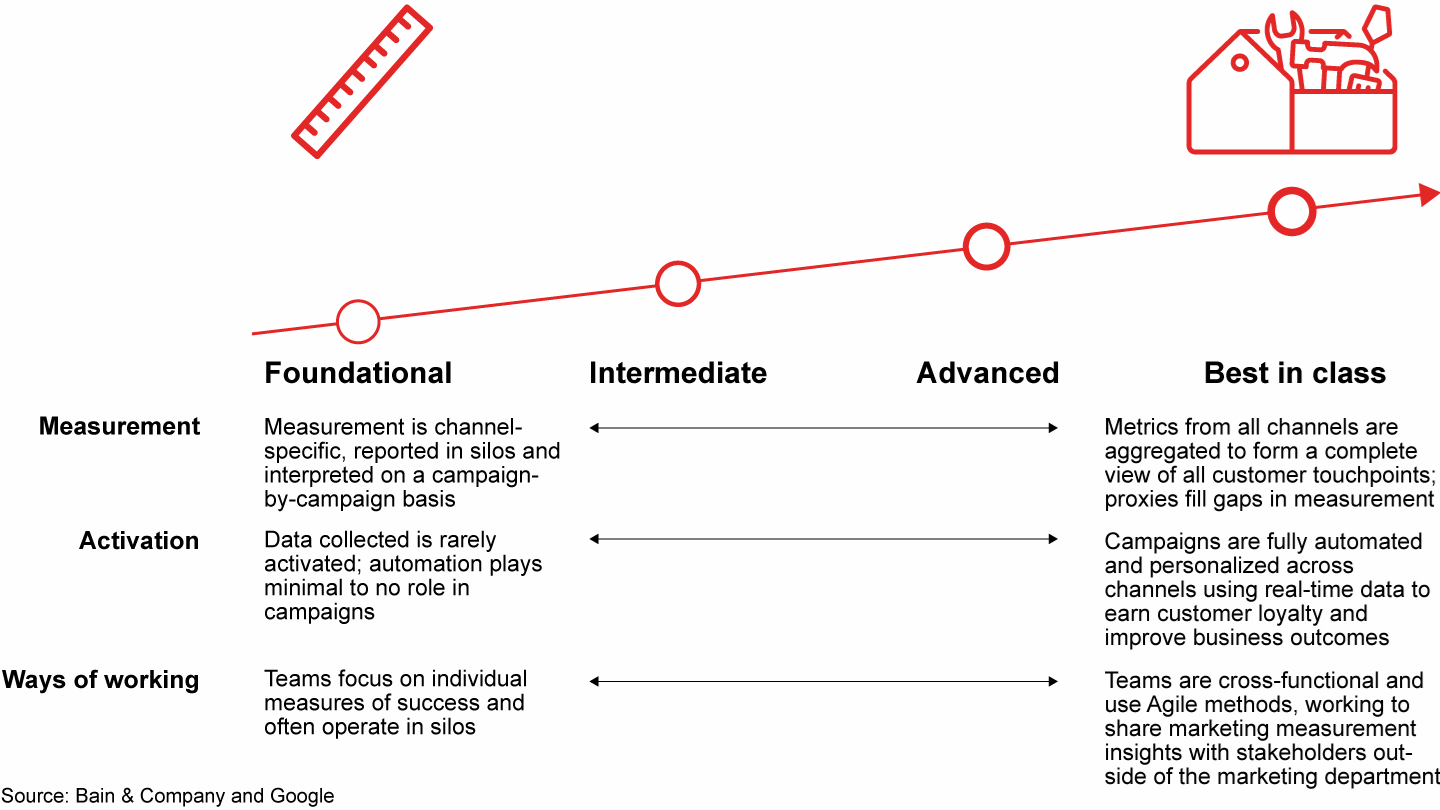

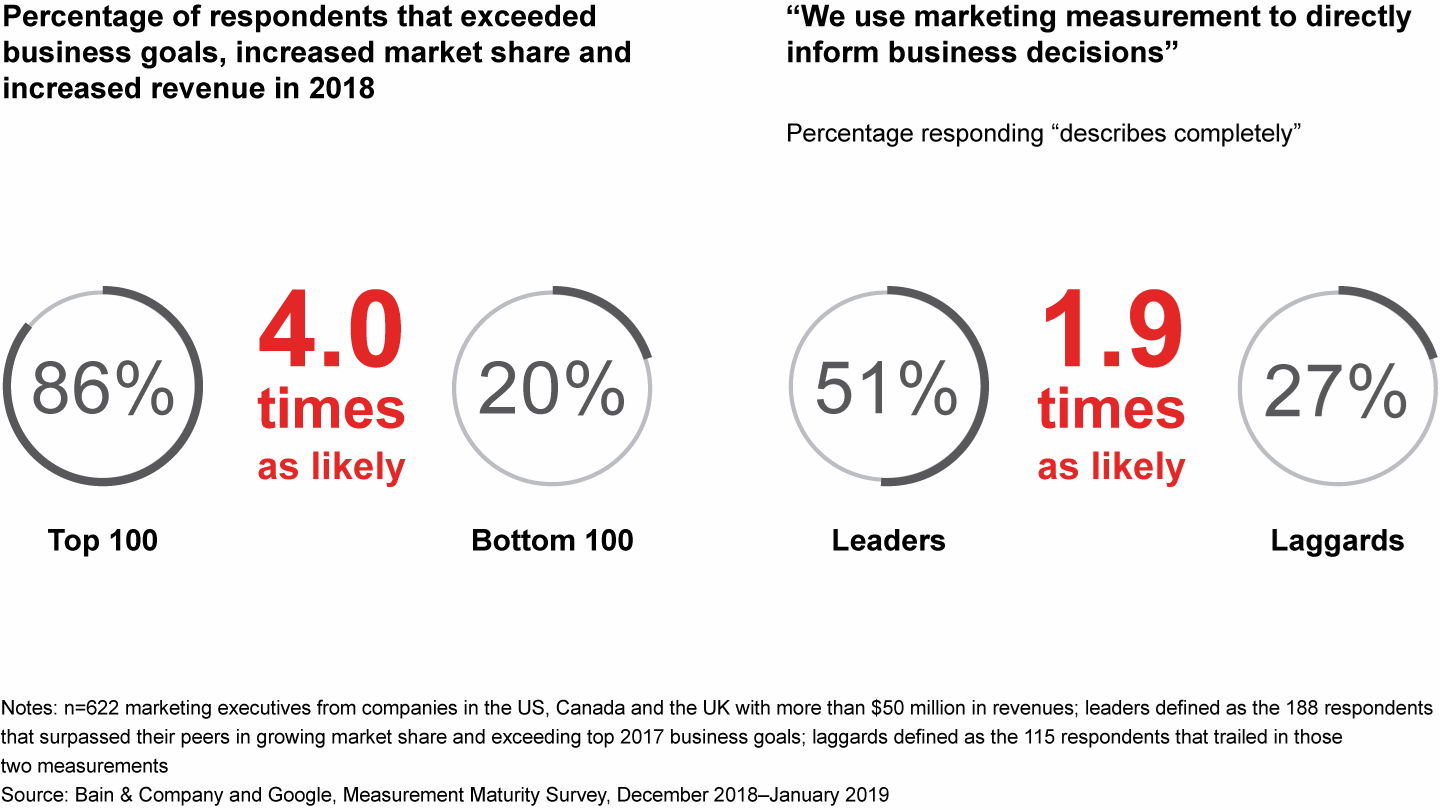
Plenty of companies measure marketing activities, of course. Yet all too often, they don’t make the most of it. For instance, their measurement does not lead to useful actions, get shared broadly among teams, or inform important strategic decisions. When one team is optimizing for website traffic and another for in-store foot traffic, but do not communicate with each other, the company will end up with a disjointed marketing strategy or investments in the wrong audiences or metrics. Marketing leaders, by contrast, mobilize teams to collaborate more across channels and departments, and thereby deliver the right experience to the right customer at the right time.
Companies at all levels of maturity recognize that measurement is important. Indeed, measurement capabilities are the fastest-growing priority for respondents’ goals and budgets, well ahead of branding perception. Measurement leaders are creating new digital divides between themselves and competitors. Organizations that have attained a measurement advantage devote substantial time and effort to excelling in three areas:
- Measurement. The leaders capture, stitch together and measure all the customer touchpoints in different data sets, until they have a deep understanding of their customers’ priorities and behaviors. They also take care to link marketing activities to business outcomes.
- Activation. They activate their measurement in order to make critical decisions. To that end, they use automation and machine-learning tools to reach and connect with customers on a large scale, yet with a high level of personalization.
- Ways of working. Agile, customer-centered teams have the authority and budget flexibility across channels to test, learn and act on measurement insights. These teams provide the essential human element to turn measurement-derived insights into marketing magic.

How Marketers Use Measurement to Beat the Competition
Leaders analyze entire customer journeys and convert those insights into action.
Measurement
With disparate internal data sources, agency partners and external ad platforms, marketers have a sea of data to work with. The challenge is how to connect different data analyses so that they generate insights that advance business goals. Measurement works best when it paints a complete picture of the entire customer journey rather than a collection of single touchpoints. For instance, the leaders among our respondents are nearly twice as likely as laggards to connect measurement platforms and ad platforms that provide a view of the whole journey (see Figure 3).

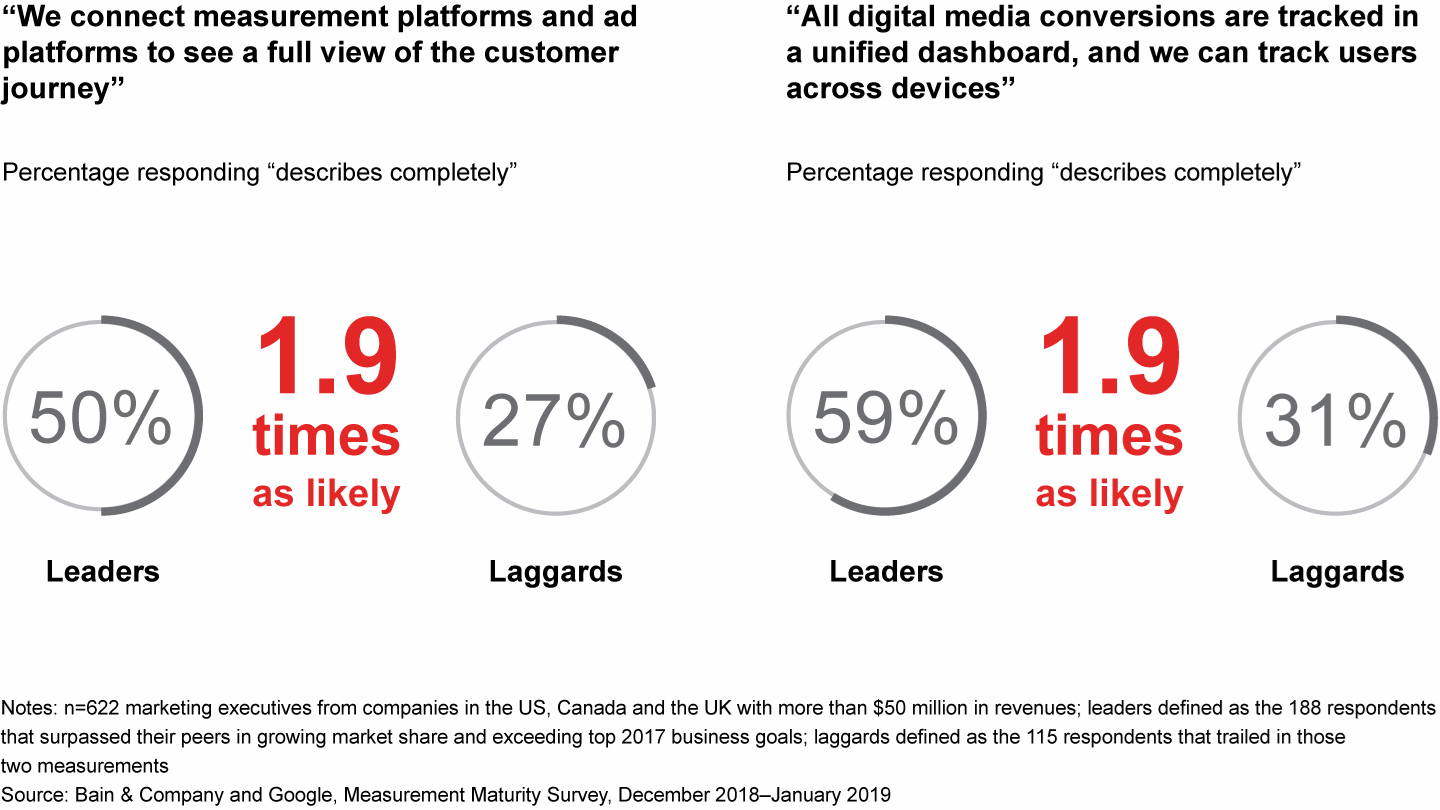
Marketing leaders understand which customers have the most value to the company on a lifetime basis, so they can create the right content for campaigns targeted to those customers. The marketing activities they generate align closely with business goals, which spurs better business outcomes.
For an illustration of how the fundamentals of measurement can transform an organization, consider the case of Cameron’s Coffee. An insurgent retail packaged-coffee brand selling mostly in the US Midwest, Cameron’s had foundational marketing capabilities just a few years ago. The new private equity owners wanted to expand the business geographically. That would require more sophisticated marketing with measurement at its heart.
Cameron’s began by focusing on customer preferences, combining website and store behavior with social media and online video testing. By testing creative variations with coffee drinkers who also expressed environmental concerns, Cameron’s learned that most buyers ranked taste over other factors. Audiences also favored blue banner ads over green or red. Those insights shaped the content and delivery of advertising and website design.
To scale up beyond the initial insights and measure the sales impact of awareness advertising, Cameron’s simulated national reach and frequency through campaigns in a few metro areas. The company tested for variables such as media mix, content and optimal timing of media. Measurement tracked both website and in-store sales, modeling how campaigns would play out in other regions with similar audience and product-distribution profiles, in order to project the investment needed to expand regionally.
A year later, Cameron’s had become one of the fastest-growing coffee brands in the country. The firm has since embedded its measurement capability to continue moving up the maturity curve.
Activation
With enough experience unlocking insights through measurement, companies can move to the next level and convert their deep customer understanding and segmentation into strategies for new customer acquisition, expanded share of wallet, and sales growth. This is where automation and machine learning are starting to prove their worth.
Still, many companies struggle to get automation right. Some companies leave money on the table because they automate only one channel, or they do not invest enough to attract the best customers, or they simply set rules based on short-term return on advertising spending (ROAS) gains rather than the longer-term business. Bain estimates, based on more than 2,250 completed tests, that marketers on average could realize 25% to 30% higher revenue over the first year for each dollar spent on advanced measurement capabilities that inform bidding and automation strategies. In fact, the marketing leaders in our analysis are 2.3 times as likely as laggards to use automation to manage bids and budgeting across more than one channel in real time (see Figure 4).

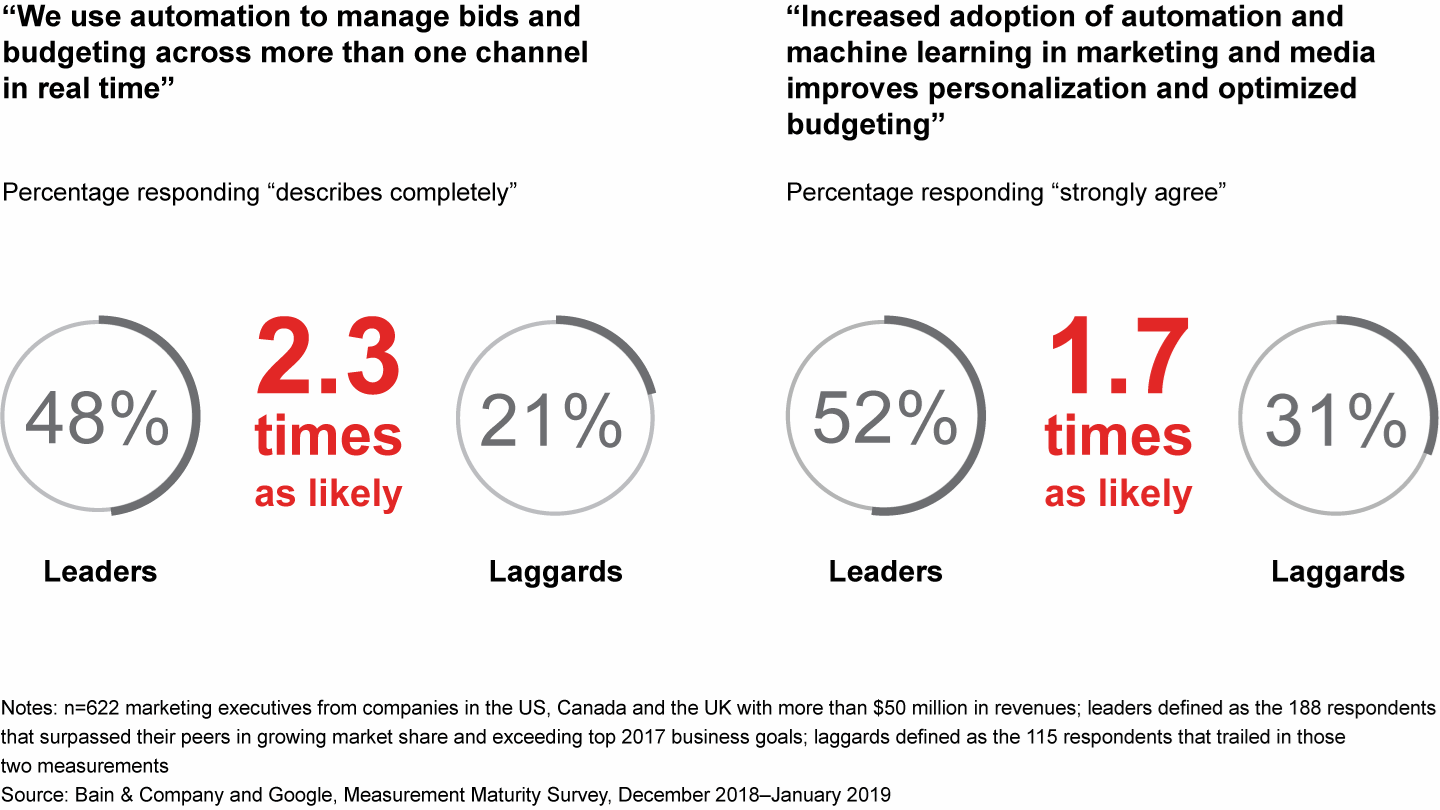
Shinola, an upscale US retailer, has long used marketing analytics and performance reports. About a year ago, Shinola executives identified measurement gaps in their marketing. It was unclear where to invest the next dollar profitably. The brand had low awareness, and growth had slowed.
The company decided to shift its measurement approach by resetting automation rules, in order to locate shoppers early in the marketing journey. It then sequenced messages to shoppers throughout their entire journey. Digital teams uncovered leading indicators of a great experience for current customers, as well as optimal content for new customers to get to know the brand. Using technologies such as Salesforce solutions, Shinola tested its way into understanding the customer’s digital journey from initial search (for, say, “best dress watch”) to in-store purchase.
This more comprehensive initiative allowed Shinola to isolate high-value customer segments, as well as the messages that lead to an initial purchase. It then knew where to invest in media that previously looked unprofitable, such as programmatic outdoor billboards, online video and midfunnel search, when consumers are in the market to buy but still searching to identify the right product. Within the first six months, nonbrand search revenues grew 209%. So far in 2019, Shinola has increased marketing investment by nearly 50% over the year-earlier period, while driving up return per dollar invested by 19%. Same-store sales rose by 24%, and e-commerce sales by 11%.
Ways of working
Marketing leaders find that shifting from channel-centered to customer-centered teams advances broader business goals. Once they organize around customer priorities, teams that have the autonomy to test and learn, unconstrained by channel- or budget-based silos or operational metrics, can deliver superior customer experiences.
Those that use Agile techniques to structure their work often can respond more quickly to new information and regulations in today’s privacy-first environment, and avoid having to execute outdated marketing plans. Our survey, for instance, finds that marketing leaders are 1.6 times as likely as laggards to organize as Agile teams centered on customer segments or campaigns (see Figure 5). And they are 1.6 times as likely to integrate and share measurement metrics with other teams.

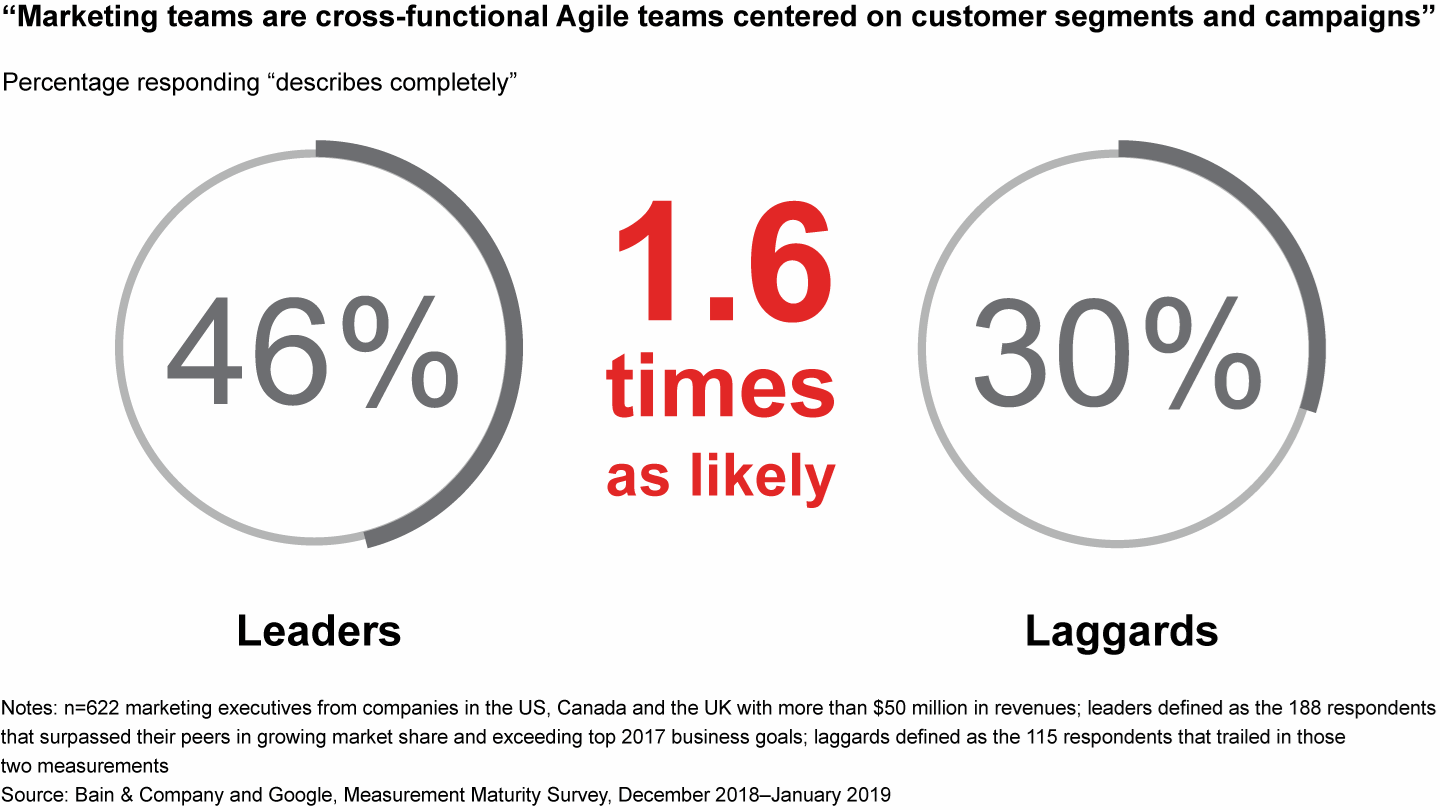
Measurement thus plays a key role in creating a customer-centered culture that embraces the test-and-learn approach. By assembling, consolidating and harnessing readily available data, marketing teams can deliver personalized, in-the-moment messages. That transforms the experience from one of feeling bombarded to one of feeling valued and informed.
Security software company McAfee deploys such teams to increase the speed of marketing tests and translate the results to better business outcomes. The number of customers researching and then purchasing McAfee products on the company website had been growing. Yet McAfee had limited access to historical performance data across all its marketing levers, as it relied largely on outsourced web operations and media buying.
To accelerate its marketing processes, McAfee gained access to its marketing data from the partners and examined the data and team capabilities. It uncovered millions of dollars in marketing opportunities, as well as a big opportunity to build skills. The company then formed Agile, cross-functional teams focused on producing minimum-viable-product test campaigns. Operating in two-week planning sprints, the teams now optimize cross-channel marketing investments in real time. In the first 90 days since forming these teams, McAfee had lowered paid search acquisition costs by 35% and overall customer acquisition costs by 22%. The company also gained full visibility of their customer data and control of media-buying technology and landing-page operations.
Key questions for executives
Mastering the discipline of measurement is a journey of many steps. CMOs and other marketing leaders committed to making measurement a priority can ask a set of useful questions to inform their next moves:
Measurement
- Are we confident we know the most effective way to invest our next $1—or our next $1 million?
- Do we have access to the internal and external metrics and data that matter?
- Does our measurement methodology weigh trade-offs among various channels?
Activation
- Have we modernized our audience segmentation? Does it include look-alike and custom-built segments? And can we engage these people in the moment, anywhere along the journey?
- Are we automating to move as fast as we can? Do we use automated digital tools for activities such as campaign autobidding and cross-channel budgeting?
Ways of working
- Do we have a fast reporting-to-decision-making process, a solid test-and-learn program, and the right capabilities in analytics, creative and DevOps?
- Does our budgeting flex across brands, products and marketing channels, so that we can reallocate funds to areas of promise revealed by tests?
Expectations for CMOs are rising, holding them accountable to demonstrate a return on marketing investment that directly affects business outcomes. It falls to CMOs to raise the level of measurement by championing the best practices and persuading teams to work together. That is how the discipline of measurement can give companies a distinct advantage in the battle to delight customers and keep them coming back for more.
The authors thank Dennis Jones, Juliette Levine, Merwin Gomes, Erin Thrope, and Thomas Lee for their contributions to this brief.